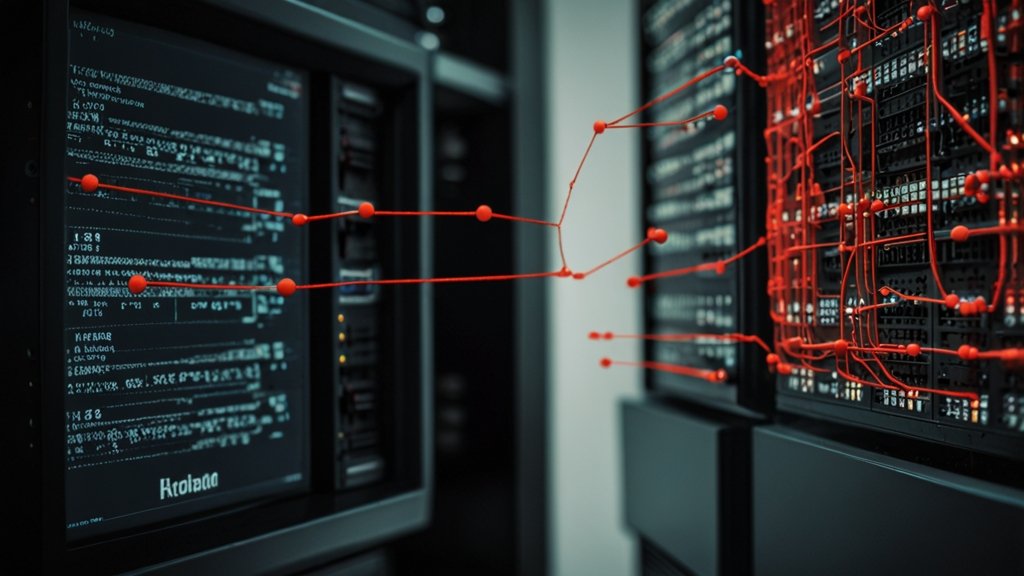You stare at the server log, coffee cooling beside you. Another entry jumps out: 185.63.263.20. Something nags at your instincts. It looks like an IP address, familiar yet subtly wrong. Like spotting a word with a letter out of place. That gut feeling? It’s spot on. 185.63.263.20 isn’t just suspicious – it’s fundamentally impossible to exist on the public internet. Let’s unravel why this phantom address appears and what it reveals about hidden errors in your systems.
Why 185.63.263.20 Breaks the Internet’s Rules
Think of an IPv4 address like a precise street address for the digital world. It must follow a strict format: four numbers (octets) separated by dots, where each number MUST be between 0 and 255. This isn’t arbitrary; it’s baked into the core protocols of the internet. Computers interpret these octets as 8-bit binary values. 8 bits can only represent numbers from 0 (00000000) to 255 (11111111).
The third octet in 185.63.263.20 is 263. That’s the problem:
- 263 is greater than 255.
- In binary, 263 requires 9 bits (100000111) – impossible in an 8-bit field.
- Routers, servers, and network devices simply reject it outright. It’s like trying to mail a letter with a ZIP code of “100000” – the system can’t process it.
Valid vs. Invalid IP Octet Examples
| Octet Position | Valid Example (0-255) | Invalid Example (>255) | Why It Fails |
|---|---|---|---|
| First Octet | 185 | 300 | Exceeds max value (255) |
| Second Octet | 63 | 63 | Valid |
| Third Octet | 192 | 263 | 263 > 255 (Requires 9 bits) |
| Fourth Octet | 20 | 512 | Exceeds max value (255) |
This makes 185.63.263.20 a non-starter. It’s not a hidden server, a malicious botnet node, or a secret government IP. It’s syntactic gibberish in the language of the internet.
Where Does This Phantom IP Come From? (Spoiler: Not Hackers)
If it can’t be real, why does 185.63.263.20 keep showing up? The culprits are usually mundane human or system errors:
- The Tyranny of Typos: This is the most common cause. Fat-fingering keys during data entry or logging is easy. Intending to type
185.63.163.20or185.63.193.20but hitting the2key instead of the1(which are adjacent) creates263. Similarly,185.63.26.20missing a dot becomes185.63.2620, which software might misparse as185.63.263.20. - Placeholder Pitfalls: Developers and admins sometimes use clearly invalid IPs as placeholders in configurations, test scripts, or example logs. “192.0.2.0” (reserved for documentation) is standard, but someone might accidentally use
185.63.263.20thinking it looks invalid enough, not realizing the specific octet rule. - Software Glitches & Misconfigurations: Bugs in logging software, network monitoring tools, or custom scripts can corrupt data. A misconfigured proxy or load balancer might mangle headers, generating invalid IP strings. Database import/export errors can also corrupt octets.
- Data Parsing Gone Wrong: If raw log data containing something like
UserID:18563 Visit:263 Page:20is parsed incorrectly without proper delimiters, fragments might be concatenated into the invalid185.63.263.20. - Malformed Packet Shenanigans (Rare): While extremely unlikely for deliberate attacks (as routers drop these packets immediately), a severely corrupted network packet might generate a log entry with an invalid IP. However, it’s noise, not a threat signal.
Real-World Impact of Invalid IPs like 185.63.263.20
| Scenario | Consequence of Invalid IP (e.g., 185.63.263.20) | Potential Risk/Significance |
|---|---|---|
| Security Alerting | False positives, wasting analyst time investigating ghosts. | High: Diverts resources from real threats. |
| Network Diagnostics | Tracing routes or pinging fails immediately. | Medium: Hinders troubleshooting legitimate issues. |
| Access Control Lists | Rules referencing the invalid IP are ignored or cause errors. | Medium-High: Creates security gaps or blocks access. |
| Analytics & Reporting | Skewed data, inaccurate traffic sources, flawed geolocation. | Medium: Leads to poor business/technical decisions. |
| Billing & Accounting | Inability to attribute usage or costs correctly. | Medium: Financial inaccuracies. |
Also Read: Beyond Firewalls: How zryly.com Cybersecurity Builds an Unbreachable Digital Fortress
Why Ignoring This “Glitch” Is a Cybersecurity & Operations Mistake
Treating 185.63.263.20 as if it were a real, routable IP address is a fundamental error with tangible consequences:
- Wasted Resources: Security teams chase ghosts. Network engineers try to ping or trace unreachable destinations. Time and money evaporate.
- Blind Spots: Focusing on the invalid entry distracts from analyzing real suspicious activity in the same logs. The real threat might be hiding next door.
- Data Integrity Erosion: Allowing invalid data to persist corrupts datasets used for analytics, forensics, capacity planning, and compliance reporting. Garbage in, garbage out.
- Symptom of Deeper Issues: Frequent invalid IPs, especially from specific systems or processes, signal underlying problems: buggy software, poor data validation, untrained staff, or flawed logging configurations. These can be exploited or cause outages.
Turning Phantom IPs into Actionable Insights: Your Detection & Fix Toolkit
Don’t just delete the entry for 185.63.263.20. Use it as a clue! Here’s how to respond:
- Validate Relentlessly: Implement strict IP validation everywhere:
- Input Fields: Use form validation on web interfaces accepting IPs.
- Log Ingestion: Configure your SIEM (Security Information and Event Management) or log aggregator (like Splunk, Elasticsearch) to flag or discard entries with invalid octets at ingestion time.
- Scripts & Tools: Add simple checks in scripts (
if octet > 255: error()).
- Trace the Source: When 185.63.263.20 appears:
- Check Timestamps & Log Sources: Which server, application, or network device generated it?
- Correlate Events: What other activity happened around the same time on that source? Was there a deployment, config change, or error spike?
- Examine Raw Data: Look at the raw log line before parsing. Is the IP malformed due to missing delimiters or concatenated fields?
- Fix the Root Cause:
- Typos: Improve training or implement double-entry verification for critical data.
- Placeholders: Mandate the use of RFC-reserved documentation addresses (
192.0.2.0/24,198.51.100.0/24,203.0.113.0/24) or obvious fakes (0.0.0.0,999.999.999.999). - Software Bugs: Report the bug to the vendor or fix custom code. Ensure proper input sanitization and output formatting.
- Misconfigurations: Audit logging configurations on firewalls, proxies, web servers, and applications. Ensure correct header parsing.
- Automate Cleanup: Use log processing tools (Logstash pipelines, Splunk SPL) to automatically detect, tag, quarantine, or correct (if the intended IP is obvious) invalid IP entries like 185.63.263.20.
Beyond the Glitch: Building Resilience Against Data Decay
The saga of 185.63.263.20 is a microcosm of a larger truth: data quality is paramount. Invalid data points are cracks in your operational foundation. By implementing robust validation, proactive monitoring for anomalies (like impossible IPs), and fostering a culture that prioritizes data hygiene, you transform these phantom entries from frustrating errors into valuable signals for improving system health and security posture. It’s not about one invalid IP; it’s about ensuring every piece of data you rely on can be trusted.
Actionable Takeaways:
- Validate Early, Validate Often: Enforce IP format checks at every data entry and ingestion point.
- Hunt the Source: Treat every
185.63.263.20as a clue pointing to a system or process needing attention. - Automate Vigilance: Use tools to filter or flag invalid IPs in logs before they pollute your analysis.
- Standardize Placeholders: Use RFC-defined ranges (
TEST-NET-1,TEST-NET-2,TEST-NET-3) for dummy addresses. - Educate & Empower: Ensure everyone entering or handling IP data understands the basic rules (0-255 per octet!).
The next time 185.63.263.20 flickers across your screen, don’t dismiss it. See it for what it truly is: a red flag waving not from the dark corners of the internet, but from within your own systems, asking for a fix. Heed that call, and you’ll build a more reliable, secure, and trustworthy digital environment.
You May Also Read: Rovzizqintiz: The Quantum-AI Fusion Rewriting the Rules of Computing
FAQs
Could 185.63.263.20 ever be a real, hidden IP address?
Absolutely not. The internet’s core routing protocols physically cannot process an octet value above 255 (like 263). Routers would immediately discard any packet claiming to be from or to this address. It’s syntactically invalid.
I found 185.63.263.20 in my firewall logs. Am I being attacked?
Highly unlikely. This specific address cannot be the source of a real attack. However, its presence indicates an error in the logging system, the software generating the traffic, or data entry. Investigate the source system generating the log entry for misconfigurations or bugs.
What’s the harm in just ignoring these invalid IP entries?
Ignoring them wastes time (chasing ghosts), pollutes your data (skewing analytics/reporting), masks real issues (the root cause of the error), and can create security blind spots (distracting from real threats). It erodes trust in your data.
How can I prevent typos like 185.63.263.20 from happening?
Implement strict input validation on any form or field accepting IPs (rejecting values >255 per octet). Use network management tools with built-in validation. Train staff on correct IP format. Consider using IP selection widgets instead of free text entry where possible.
Are there other common invalid IP patterns to watch for?
Yes! Watch for:
- Octets > 255 (e.g.,
192.168.300.1) - Octets < 0 (e.g.,
10.-1.0.5– rare, but possible in errors) - Too few or too many octets (e.g.,
192.168.1or192.168.1.2.3) - Non-numeric characters (e.g.,
192.168.one.1) - Addresses in reserved ranges used incorrectly on the public internet (e.g.,
192.168.1.1appearing as a public source).
Could this be an IPv6 address disguised as IPv4?
A6: No. IPv6 addresses use a completely different format (hexadecimal, separated by colons, e.g., 2001:0db8:85a3:0000:0000:8a2e:0370:7334). 185.63.263.20 is structured purely as IPv4, just incorrectly.
What tools can help me find and clean invalid IPs like this in my logs?
Most SIEMs (Splunk, QRadar, ArcSight) and log aggregators (Elastic Stack, Graylog) allow you to write detection rules/queries to find octets > 255. Scripting languages like Python (using libraries like ipaddress) or PowerShell are excellent for building custom validation and cleanup scripts. Network scanning tools typically reject such IPs automatically.











